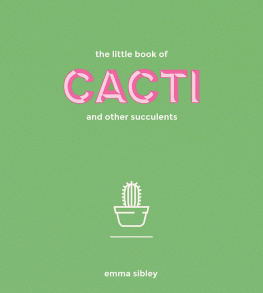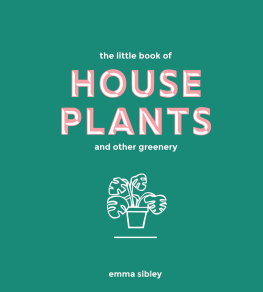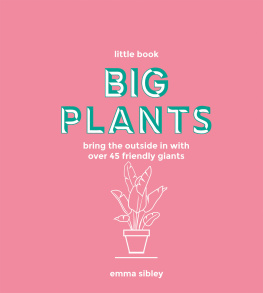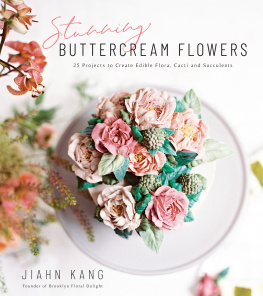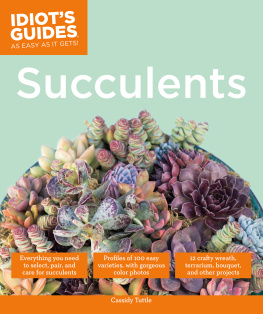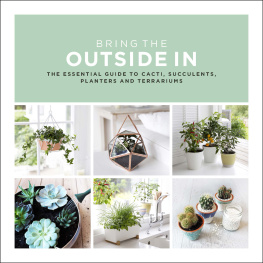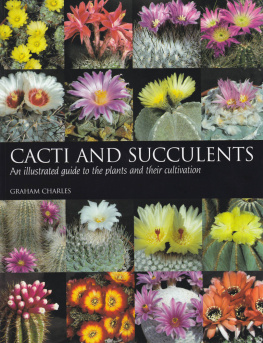Emma Sibley - The Little Book of Cacti and Other Succulents
Here you can read online Emma Sibley - The Little Book of Cacti and Other Succulents full text of the book (entire story) in english for free. Download pdf and epub, get meaning, cover and reviews about this ebook. year: 2017, publisher: Quadrille, genre: Children. Description of the work, (preface) as well as reviews are available. Best literature library LitArk.com created for fans of good reading and offers a wide selection of genres:
Romance novel
Science fiction
Adventure
Detective
Science
History
Home and family
Prose
Art
Politics
Computer
Non-fiction
Religion
Business
Children
Humor
Choose a favorite category and find really read worthwhile books. Enjoy immersion in the world of imagination, feel the emotions of the characters or learn something new for yourself, make an fascinating discovery.
- Book:The Little Book of Cacti and Other Succulents
- Author:
- Publisher:Quadrille
- Genre:
- Year:2017
- Rating:5 / 5
- Favourites:Add to favourites
- Your mark:
- 100
- 1
- 2
- 3
- 4
- 5
The Little Book of Cacti and Other Succulents: summary, description and annotation
We offer to read an annotation, description, summary or preface (depends on what the author of the book "The Little Book of Cacti and Other Succulents" wrote himself). If you haven't found the necessary information about the book — write in the comments, we will try to find it.
The Little Book of Cacti and Other Succulents — read online for free the complete book (whole text) full work
Below is the text of the book, divided by pages. System saving the place of the last page read, allows you to conveniently read the book "The Little Book of Cacti and Other Succulents" online for free, without having to search again every time where you left off. Put a bookmark, and you can go to the page where you finished reading at any time.
Font size:
Interval:
Bookmark:



I would love to dedicate this book to my grandparents, Ben and Ethel Howard, for passing on their green fingers to me.
Contents
WHAT ARE CACTI AND SUCCULENTS?
Cacti and succulents are plants that can store water in their leaves and stems, which allows them to survive in very dry places. All cacti are succulents; cacti have areoles small, round, cushion-like bumps from which spines grow but succulents have none.
These hardy plants have been part of the horticultural scene for a long time, but they have become increasingly popular with urban gardeners and green-fingered city dwellers in the past few years.
Today there is a greater choice of houseplants than ever before in specialist stores, garden centres and florists, with a wide variety of cacti and succulents to pick from. We have, however, become accustomed to seeing the Organ Pipe and Prickly Pear Cactus in Hollywood films, but there are many more forms with globular bodies and unusual leaf shapes and textures, such as the hanging Fishbone and Pencil Cacti.
There is a common belief that these low-maintenance plants can survive all forms of neglect, but this is not always true. This book aims to describe a selection of some of the better-known cacti and succulents, as well as more obscure and hard-to-find ones. It will also shed some light on the best watering habits, where to position your plants, and how to deal with any problems that may occur.
HOW TO USE THIS BOOK
Each plant entry includes key information about caring for that particular variety. All the information is clearly organized under appropriate symbols which will help you give your plants everything they need to grow and thrive.
KEY TO SYMBOLS
 | LIGHT |
 | WATER |
 | GROWTH AND CARE |
 | POTTING |
 | FLOWERS |
 | PRUNING |
 | PROPAGATION |
 | WATCH OUT FOR |
 | QUIRKS |
 | DID YOU KNOW |
Each plant is given its common and Latin name; occasionally these are the same. The Latin or botanical name provides information about the relationship between plants and is known as the taxonomic status. All plants belong to a particular family and these are divided into genera (the plural of genus). The Latin name of each plant consists of two words; the genus and the species. The genus is a collective name for a group of plants, and the species (or specific epithet) tells you more about a particular plant.

BUYING YOUR PLANTS
I believe that after purchasing your first prickly friend, the decision to start a collection of cacti and succulents is almost taken out of your hands. An addiction to these plants seems to take hold.
You can purchase cacti and succulents almost anywhere; local florists, online growers and specialist stores are all ideal places to begin your hunt. Dont be afraid to ask if you want something in particular to grow your collection.
The succulents and cacti you can pick up from your local garden centre are often growing in small, solitary pots containing one or two rosettes, so the opportunity to pick up a few of these at a time and grow them together is a joy in itself.
How often do you see a cactus or succulent standing lonesome on a window ledge? They are almost always accompanied by a second or third potted friend.
HANDY TIPS
When choosing your plants, consider the health of the plant. Watch out for scarring, dying leaves, root rot, damage or discolouration. Most importantly, make sure your plant doesnt have any bugs or diseases. Dont fall into the trap of feeling sorry for a plant because you will end up having to do more work to try to revive it.
ESSENTIAL EQUIPMENT

CLAY OR CONCRETE POTS
These are ideal for cacti and succulents because the walls are porous and allow excess water through. Plants are usually sold in plastic pots, which are less attractive than clay pots, but do help the plants retain moisture.
WATERING
It is always handy to have a watering can to make the task of hydrating/feeding your plants fun. Youll find some plants prefer to be watered with a mister.
COMPOST AND GRAVEL
Most collectors have their own recipe for the ideal compost mix; however it is perfectly acceptable to pick up ready-mixed cacti and succulent compost in your local garden centre. This is a sandy and gritty mixture that allows good drainage for the roots. Ensure that the compost you use is loose and aerated, even when wet, to prevent waterlogging and root rot. You will need to put a layer of gravel or small stones in the bottom of each pot to help with drainage.
OTHER TOOLS
Trowels come in a range of sizes and are useful for mixing soil and repotting plants. Buy a sturdy pair of gardening gloves; without these repotting can be a painfully prickly business! A small pair of cactus grippers or tweezers is also useful for pruning and propagating your plant.

PROPAGATION IS THE PROCESS OF CREATING NEW PLANTS FROM A CUTTING, AN OFFSET OR A SEED.
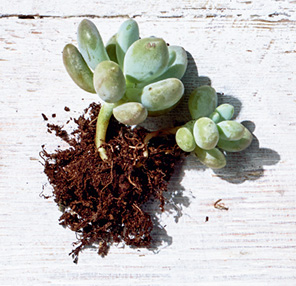
Once you are the owner of a cactus or succulent you will be able to start creating your own collection. Propagation can be done in several ways; the most popular ways are taking cuttings and raising plants from seed.
CUTTINGS
Many cacti and succulents produce pups or offsets (small versions of themselves) in the first few years of growth. These can be removed from the parent plant, rooted and then repotted. You can remove one of the fleshy leaves of a plant such as a Houseleek or Burros Tail very easily without damaging the rest of the plant. If you place this leaf on a bed of dry, gritty soil you will soon notice that the cut surface dries and hardens, forming a callus; shortly afterwards it will start to root. When rooting, keep cuttings in light shade to prevent them shrivelling. Small plantlets should begin to sprout from the base of the original leaf, which means it can then be planted. The original leaf will eventually die back, leaving room for the new plant to grow.
Font size:
Interval:
Bookmark:
Similar books «The Little Book of Cacti and Other Succulents»
Look at similar books to The Little Book of Cacti and Other Succulents. We have selected literature similar in name and meaning in the hope of providing readers with more options to find new, interesting, not yet read works.
Discussion, reviews of the book The Little Book of Cacti and Other Succulents and just readers' own opinions. Leave your comments, write what you think about the work, its meaning or the main characters. Specify what exactly you liked and what you didn't like, and why you think so.

